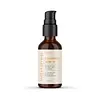What's inside
What's inside
 Key Ingredients
Key Ingredients

 Benefits
Benefits

 Concerns
Concerns

 Ingredients Side-by-side
Ingredients Side-by-side

Water
Skin ConditioningGlycerin
HumectantSodium Ascorbyl Phosphate
AntioxidantCitrus Paradisi Peel Oil
MaskingHamamelis Virginiana Extract
AntiseborrhoeicCassia Angustifolia Seed Polysaccharide
Skin ConditioningSodium Hyaluronate
HumectantGlobularia Cordifolia Callus Culture Extract
Skin ConditioningGlycyrrhiza Glabra Root Extract
BleachingCamellia Sinensis Leaf Extract
AntimicrobialGinkgo Biloba Leaf Extract
Skin ConditioningFucus Vesiculosus Extract
EmollientPunica Granatum Extract
AstringentArgania Spinosa Kernel Oil
EmollientLaminaria Saccharina Extract
Skin ProtectingCamellia Oleifera Leaf Extract
AstringentRosa Canina Fruit Oil
EmollientHippophae Rhamnoides Fruit Oil
Skin ProtectingFerulic Acid
AntimicrobialLimnanthes Alba Seed Oil
Skin ConditioningGlucosyl Hesperidin
HumectantRosmarinus Officinalis Leaf Extract
AntimicrobialCentella Asiatica Extract
CleansingHibiscus Rosa-Sinensis Flower Extract
HumectantCarbomer
Emulsion StabilisingTocopherol
AntioxidantDaucus Carota Sativa Seed Oil
EmollientPrunus Armeniaca Kernel Oil
MaskingEquisetum Arvense Extract
AstringentTaraxacum Officinale Leaf Extract
Skin ConditioningGeranium Maculatum Extract
TonicHelianthus Annuus Seed Oil
EmollientXanthan Gum
EmulsifyingSodium Hydroxide
BufferingPropanediol
SolventPhenethyl Alcohol
MaskingPentylene Glycol
Skin ConditioningWater, Glycerin, Sodium Ascorbyl Phosphate, Citrus Paradisi Peel Oil, Hamamelis Virginiana Extract, Cassia Angustifolia Seed Polysaccharide, Sodium Hyaluronate, Globularia Cordifolia Callus Culture Extract, Glycyrrhiza Glabra Root Extract, Camellia Sinensis Leaf Extract, Ginkgo Biloba Leaf Extract, Fucus Vesiculosus Extract, Punica Granatum Extract, Argania Spinosa Kernel Oil, Laminaria Saccharina Extract, Camellia Oleifera Leaf Extract, Rosa Canina Fruit Oil, Hippophae Rhamnoides Fruit Oil, Ferulic Acid, Limnanthes Alba Seed Oil, Glucosyl Hesperidin, Rosmarinus Officinalis Leaf Extract, Centella Asiatica Extract, Hibiscus Rosa-Sinensis Flower Extract, Carbomer, Tocopherol, Daucus Carota Sativa Seed Oil, Prunus Armeniaca Kernel Oil, Equisetum Arvense Extract, Taraxacum Officinale Leaf Extract, Geranium Maculatum Extract, Helianthus Annuus Seed Oil, Xanthan Gum, Sodium Hydroxide, Propanediol, Phenethyl Alcohol, Pentylene Glycol
Water
Skin ConditioningGlycerin
HumectantAlcohol
AntimicrobialDipropylene Glycol
HumectantButylene Glycol
HumectantPEG/PPG/Polybutylene Glycol-8/5/3 Glycerin
HumectantNiacinamide
SmoothingHydroxyethylpiperazine Ethane Sulfonic Acid
BufferingBis-PEG-18 Methyl Ether Dimethyl Silane
Emollient3-O-Ethyl Ascorbic Acid
Skin ConditioningIsononyl Isononanoate
EmollientBHT
AntioxidantLinalool
PerfumingGeraniol
PerfumingParfum
MaskingSalicylic Acid
MaskingSodium Citrate
BufferingSodium Hyaluronate
HumectantPhenoxyethanol
PreservativePhenylethyl Resorcinol
AntioxidantAdenosine
Skin ConditioningAmmonium Polyacryloyldimethyl Taurate
Emulsion StabilisingTocopheryl Acetate
AntioxidantDisodium EDTA
Limonene
PerfumingHydrogenated Lecithin
EmulsifyingCitric Acid
BufferingCitrus Limon Fruit Extract
MaskingCitrus Junos Fruit Extract
Skin ConditioningXanthan Gum
EmulsifyingMaltodextrin
AbsorbentAcetyl Trifluoromethylphenyl Valylglycine
Skin ConditioningOxothiazolidinecarboxylic Acid
Skin ConditioningBenzyl Salicylate
PerfumingBenzyl Alcohol
PerfumingWater, Glycerin, Alcohol, Dipropylene Glycol, Butylene Glycol, PEG/PPG/Polybutylene Glycol-8/5/3 Glycerin, Niacinamide, Hydroxyethylpiperazine Ethane Sulfonic Acid, Bis-PEG-18 Methyl Ether Dimethyl Silane, 3-O-Ethyl Ascorbic Acid, Isononyl Isononanoate, BHT, Linalool, Geraniol, Parfum, Salicylic Acid, Sodium Citrate, Sodium Hyaluronate, Phenoxyethanol, Phenylethyl Resorcinol, Adenosine, Ammonium Polyacryloyldimethyl Taurate, Tocopheryl Acetate, Disodium EDTA, Limonene, Hydrogenated Lecithin, Citric Acid, Citrus Limon Fruit Extract, Citrus Junos Fruit Extract, Xanthan Gum, Maltodextrin, Acetyl Trifluoromethylphenyl Valylglycine, Oxothiazolidinecarboxylic Acid, Benzyl Salicylate, Benzyl Alcohol
 Reviews
Reviews

Ingredients Explained
These ingredients are found in both products.
Ingredients higher up in an ingredient list are typically present in a larger amount.
Glycerin is already naturally found in your skin. It helps moisturize and protect your skin.
A study from 2016 found glycerin to be more effective as a humectant than AHAs and hyaluronic acid.
As a humectant, it helps the skin stay hydrated by pulling moisture to your skin. The low molecular weight of glycerin allows it to pull moisture into the deeper layers of your skin.
Hydrated skin improves your skin barrier; Your skin barrier helps protect against irritants and bacteria.
Glycerin has also been found to have antimicrobial and antiviral properties. Due to these properties, glycerin is often used in wound and burn treatments.
In cosmetics, glycerin is usually derived from plants such as soybean or palm. However, it can also be sourced from animals, such as tallow or animal fat.
This ingredient is organic, colorless, odorless, and non-toxic.
Glycerin is the name for this ingredient in American English. British English uses Glycerol/Glycerine.
Learn more about GlycerinSodium Hyaluronate is hyaluronic acid's salt form. It is commonly derived from the sodium salt of hyaluronic acid.
Like hyaluronic acid, it is great at holding water and acts as a humectant. This makes it a great skin hydrating ingredient.
Sodium Hyaluronate is naturally occurring in our bodies and is mostly found in eye fluid and joints.
These are some other common types of Hyaluronic Acid:
Learn more about Sodium HyaluronateWater. It's the most common cosmetic ingredient of all. You'll usually see it at the top of ingredient lists, meaning that it makes up the largest part of the product.
So why is it so popular? Water most often acts as a solvent - this means that it helps dissolve other ingredients into the formulation.
You'll also recognize water as that liquid we all need to stay alive. If you see this, drink a glass of water. Stay hydrated!
Learn more about WaterXanthan gum is used as a stabilizer and thickener within cosmetic products. It helps give products a sticky, thick feeling - preventing them from being too runny.
On the technical side of things, xanthan gum is a polysaccharide - a combination consisting of multiple sugar molecules bonded together.
Xanthan gum is a pretty common and great ingredient. It is a natural, non-toxic, non-irritating ingredient that is also commonly used in food products.
Learn more about Xanthan Gum